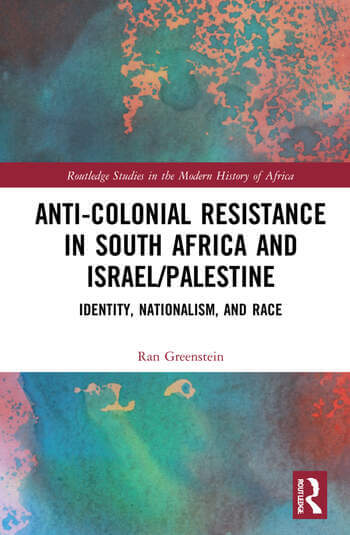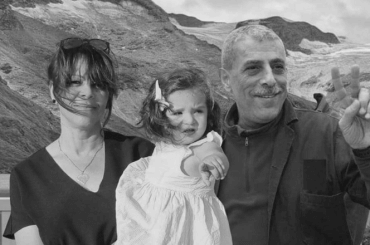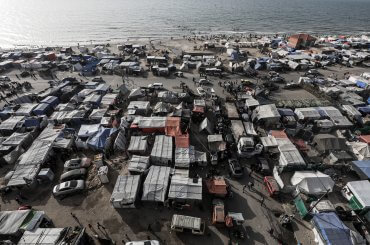ANTI-COLONIAL RESISTANCE IN SOUTH AFRICA AND ISRAEL/PALESTINE
Identity, Nationalism, and Race
by Ran Greenstein
244 pps. Routledge $128
Human rights organizations Amnesty International, Human Rights Watch, and B’Tselem have determined Israel’s rule of Palestinians meets the criteria for the internationally-designated crime of apartheid, a crime against humanity named after the system of laws that enshrined white-minority rule in South Africa between 1948 and 1994.
A new book by South African-Israeli sociologist Ran Greenstein, Anti-Colonial Resistance in South Africa and Israel/Palestine, is a natural source for the similarities and differences that exist between the human rights struggles of Israel/Palestine and South Africa.
Greenstein has previously in his career addressed the history of both the victory for majority rule in South Africa, and the history of anti-colonial resistance in Palestine, including a previous book from 2014, which traces, the small democratic movements overtaken by the momentum of Jewish nation-state nationalism (and the oppression that it required), from the onset of the Zionist project onward.
The purpose of this new book is to observe the differences and similarities in these particular versions of both colonialism and resistance.
One might think these could lead to envisioning how Israel/Palestine could experience a similar transition from an oppressive ethnonational state to democracy, as South Africa did. Yet Greenstein’s argument is slightly more sobering, concluding that Palestinians do not now have the traction to force a “South African solution” leading to a peaceful agreement modeled after the framework of majority rule with protections for minorities.
Greenstein explains his reasoning in his concluding chapters (after first taking us through a review of the histories of resistance in South Africa and Palestine). Here, Greenstein critiques the usefulness of “settler colonialism” as a label and an analytical category when applied to both South Africa and Palestine:
Its strongest point is also its weakest: it is applicable to a great diversity of conditions.
It can be applied to societies in which settlers overwhelmed the indigenous population to the point that it became negligible, no more that 2–3% of the population in the United States of America (USA), Canada, and Australia… [and can be applied to places like] Kenya, Rhodesia, Algeria, Mozambique, and South Africa – [where] indigenous people remained the bulk of the population and the main source of labour power.
Greenstein notes that Palestinians are demographically divided into four main groups — citizens of Israel, residents of the occupied West Bank and Gaza, neighboring refugees, and the worldwide diaspora of Palestinians — all with different priorities and ranges of activity.
In contrast to white South Africa, which was absolutely dependent on the labor of non-whites, Israel needs nothing from Palestinians except that they mostly leave and never return.
Even with the existence of solidarity between those groups, Greenstein argues that the record shows an inability on the part of these disparate communities to seriously threaten the continuation of the Zionist state and its dedication to Jewish control.
In contrast to white South Africa, which was absolutely dependent on the labor of non-whites, Israel needs nothing from Palestinians except that they mostly leave and never return. Labor from the West Bank (and previously, from Gaza) is useful but not essential.
Greenstein asserts that in the South African case, external boycott pressure against apartheid supplemented the robust power of years of organizing the African and “colored” workforce, together with a broad civil resistance movement led by the African National Congress.
He says that the Boycott, Divestment and Sanctions (BDS) campaign abroad, though admirable and worthwhile, cannot augment missing Palestinian power, and nor can it exert pressure on the Israeli regime on its own.
The Israel/Palestine system meets the definition of apartheid in international law but presents different challenges for the campaign against it than was the case for the anti-apartheid movement in South Africa. The most important of these is the challenge of effecting change from within when the bulk of the forces seeking such change are located without, both physically and conceptually.
In Greenstein’s opinion, expecting the same results as boycotts of white-ruled South Africa ends up ignoring the most important part of South Africa’s anti-apartheid strategy: “the internal mass struggle to undermine and transform the political system from within.”
Greenstein points out that throughout its history, white supremacy in South Africa “was a means to ensure white prosperity, using black labour as its foundation.” Apartheid was just an institutionalized continuation of that history, and a means of entrenching “white domination.”
In contrast, Zionist colonization was of the land, not the people. “Hebrew labor” and the “Conquest of the Land” were the main slogans during the era of the pre-1948 Yishuv.
Zionist projects meant armed Zionist settlements with Jewish-only workers, Jewish-only enterprises, Jewish-only commercial channels, and Jewish-only land purchases by the Jewish National Fund (ever since 1901) “for the Jewish people,” all of this being in service of creating a “self-sufficient” Jewish society that could operate independently of the indigenous Palestinian population, even before the Nakba.
Land bought by the Zionist organization meant tenant farmers were removed. This confirmed the meaning of Zionist immigration — to Arabs — as dislocation and beggary in their own country, as properties were turned to enterprises, intentionally to the exclusive benefit of Jews.
Understanding the nature of Jewish settlement organized by Zionist organizations makes clear why developing pressure for a resolution by mutual accommodation is elusive, as Zionist doctrines only value Jewish hegemony, as isolated as possible from Arabs, despite PR flim-flam.
Greenstein analyzes the difference as follows:
Israel/Palestine has experienced a different trajectory, producing two distinct ethno-national groups competing over territory and resources, without entering into relations of inter-dependence as was the case in South Africa…Political domination was primarily a means to an economic end in South Africa and an end in itself in Israel/Palestine.
There is one function that the population of the West Bank and Gaza serve for Israel’s biggest new industry — world-wide arms and security technology sales. Jeff Halper describes the Palestinians residing there as the test bed for new product development.
The power of Israel to use, at will, a matrix of high-tech surveillance and targeted assasination, is refined and developed when it is used against Palestinian resistance, sumud, and bare human determination, as Mariam Barghouti has reported in her profile of Ibrahim Nabulsi, the “lion of Nablus.”
Greenstein diagrams the power relations in South Africa and Palestine in the twentieth century that reduced Palestinian resistance to individual martyrs with personal weapons against a technologically modern army, and to various militias that can fire low-grade rockets.
With much of its population exiled from Israel proper in 1947-48, the Palestinian resistance/liberation movement needed to organize in neighboring Arab states. This made the Palestinian resistance beholden to inconstant external “allies” that Israel had the resources to threaten or co-opt. He wonders if the movement would have done better to have had no support — or at least have done no worse.
Outside support ultimately hobbled developing a unified Palestinian-centered front and goals, alternating between Palestinian, pan-Arab nationalist, religious-affiliated, international Communist, and big power politics imperatives.
Fatally, what joint Jewish-Arab organizing that does exist is not a mass movement. Greenstein points out that 100 years of Zionist work forced a rigid Jewish/non-Jewish binary in Palestine, forestalling significant alliances based on other shared interests and identities across that chasm.
A unifying set of articulated goals was one of the strengths of the anti-apartheid movement in South Africa. When the time came for negotiations there was an agreed set that could be forcefully demanded, with thought-through features of universal respect of rights that enabled white acceptance.
The ANC could offer both the credible threat of making apartheid governance impossible — using labor actions and mass mobilizations — and credible plans for a multi-racial democracy.
A sobering conclusion
The basic thrust of Greenstein’s thesis is that something will have to change to end Israeli ethnonationalist domination from the river to the sea. This conclusion is not bright and hopeful. The nationalisms of Palestine and Zionist Israel have no overlap that can lead to foreseeing a “South African-style” negotiated resolution based on a shared identity between dominator and subjugated.
This conclusion has political implications. The project of Israeli settlement beyond the 1949 armistice lines means the time of the internationally-favored “two-state solution” is over. In fact, it was never really a serious Israeli goal to begin with.
The now many human rights reports that have found Israel guilty of the crime of apartheid have also highlighted how the pressing need for Palestinian freedom and political rights is a direct mirror of the imperative for freedom that animated the anti-apartheid movement int South Africa, including the need to equitably share resources, but without any obvious road to that goal — except through bloody cataclysm.
It may seem that Greenstein is indulging in an academic exercise by comparing what South Africa was able to achieve to the struggle of Palestine. But without intoxicating rhetoric and cheer leading, he ventures his consideration of Palestine’s struggle against its own versions of apartheid and settler colonialism, and whether any common interests can cross the rigid Zionist distinction of Jewish Israeli and Arab Palestinian.
This book is no polemic; it does not aim to argue that the partition in 1947 was wrong, or that the Nakba was a historic crime, or that the occupation is a continuation of that Zionist original sin. Those are all given.
Justice must be accompanied by the exercise of effective pressure in order to realize it. The question then becomes: by what forces?
Rather, the assumption and implicit exploration of the book is that proving the justice of the Palestinian cause will do nothing alone. Justice must be accompanied by the exercise of effective pressure in order to realize it. The question then becomes: by what forces?
One may very well ask at this point what relevance South Africa holds for the future of Palestine? Does Greenstein’s survey of organizing strategies in both countries matter?
For this author, it seems that the example of South Africa is relevant because it is a case of brutal repression based on race. Concerted pressure and negotiation created a new country based on shared citizenship with multiple identities.
It’s worth at least a look at how that happened, considering the suffering built into the alternatives for Israel/Palestine — an ugly situation of brutal repression based on ethnicity, and a constant train of martyrs.




How much longer can apartheid last? Arnon Soffer, a professor of geography at Haifa University (aka ‘the Arab counter’) says –
https://www.timesofisrael.com/jews-now-a-minority-in-israel-and-the-territories-demographer-says/
Jewish people make up less than 47 percent of all those living west of the Jordan River, an Israeli demographer warned Tuesday, claiming that most of the Israeli population is unaware of the democratic peril the country is sliding into by possibly becoming a ruling minority in the area….According to Soffer, there are 7.45 million Jews and others along with 7.53 million Arab Israelis and Palestinians living in what he termed the Land of Israel, meaning Israel plus the West Bank and Gaza Strip.
Economically, South Africa is still in the hands of the whites. And Israel uses “guest workers,” who have no rights, aren’t allowed to convert to Judaism even when they want to, and whose Israeli-born children are not Israeli citizens.
I’ve been asked where is the Palestinian Mandela? The answer: in exile, in an Israeli prison, or dead. But the real question is: Where is the Israeli de Klerk? Nowhere to be seen.
@Jon s
“RoHa , Seems to me to be common-sense logic: you’re not an “invader ” in your homeland.”
I didn’t expect you to understand logic, and I see that you don’t. You can’t establish your conclusion from a single premise.
First, the land under discussion isn’t the homeland of the Jewish “people”. It’s the historic homeland of the Jp. You said so yourself.
And we have established, slowly and painfully, that “historic homeland” means (a) the place the Jewish religion started and (b) the place that Jews have sentimental feelings about as a result of (a). The combination of a and b makes Palestine the historic homeland of the Jews.
My argument is as follows:
A polish Jew, born and brought up in Poland, from ancestors who have been in Poland for generations, with Polish citizenship, and who has never been to Palestine, is a foreigner to Palestine. Palestine is not his country. Poland is his country.
If that Polish Jew enters Palestine with the intent of taking over the country (either alone or with the assistance of other people) he is a foreign invader. (That is what invaders do.)
This description applies to the early Zionists.
Therefore, they were invaders.
What you have to do.
You have to show that the combination of a and b gives that foreign Jew the right to enter the country, take over the country, and even to drive out the native people of the country.
Now do you understand?
The premise of the book is true, in that the fall of apartheid South Africa was not because of the moral position of the regime- which always had cleaner hands than the so-called state of ‘israel’- but because elements within the capitalist class in South Africa, particularly the Oppenheimers, following the fall of the Soviet Union saw that they could make greater profits with apartheid gone. Those same forces continue to support their evil home base of ‘israel’.
“justice of the Palestinian cause will do nothing alone. Justice must be accompanied by the exercise of effective pressure in order to realize it.”
______________________________________________________
The basic question revolves around what will be effective. We have learned what is not.